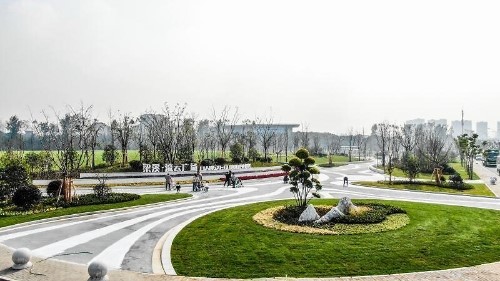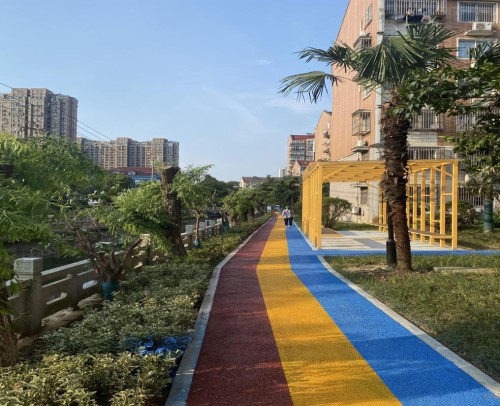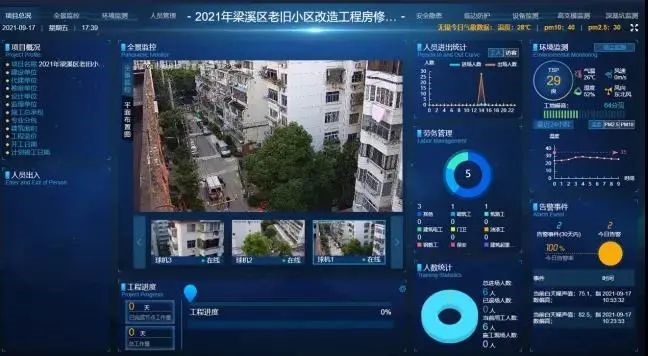District in E China advances urban renewal with green, low-carbon philosophy
Green and low-carbon development philosophy is a guiding principle for the regeneration of old residential communities in Liangxi district, Wuxi of east China's Jiangsu province, a national-level pilot area for urban renewal projects.

Photo shows an urban square in Liangxi district, Wuxi, east China's Jiangsu province. (Photo from the official website of the government of Liangxi district)
Multiple measures have been taken in the district to give it a facelift. Nowadays, modern buildings are erected by the sides of clean streets, and the water quality in the Wuxi section of the Grand Canal, a 2,500-year-old water course linking north and south China, has also been largely improved. As a result, the sense of happiness of local residents has been greatly enhanced.
"Now the district is a great place to live and work in, and we enjoy the dividends of green development everyday here," said Li Nan, who once moved to suburban areas for better environment and recently moved back.
Besides, the district is also vigorously developing low-carbon industries and modern services. New business forms are prospering there, including cross-border e-commerce, headquarters economy, digital economy and the integrated sector of culture and tourism.
While advancing urban renewal, local authorities gave red lights to high-energy consuming and high-emission traditional industries, such as paint making, electroplating and chemical engineering, to make room for green and low-carbon businesses.
"With the goal to peak carbon emission and achieve carbon neutrality, and based on the environmental capacity of old residential communities, we have strictly controlled the total emissions of pollutants and developed producer services in a targeted manner to promote high-quality and low-carbon development of industries," said Wang Shu, deputy head of Liangxi's ecology and environment bureau.

Photo shows tracks paved in a renovated old residential complex in Liangxi district, Wuxi, east China's Jiangsu province. (Photo from the official website of the government of Liangxi district)
Liangxi's green development is inseparable from a science-based structure and intelligence management. By building a demonstration area for industry-city integration, the district has combined together its work and commercial areas, and placed residential communities around work areas, which has made the city more compact and significantly shortened the commuting distance of the citizens, and thus alleviating traffic jams and reducing air pollution. In addition, the district is also employing 5G technology and advanced devices to monitor sewage discharge in 150 local rivers.
Liangxi district has made sound achievements in pollution control and emission reduction through circular economy.
Yangming neighborhood of the district houses a large number of enterprises. It has built a big data storage center on a piece of land where a polluting enterprise was once operating. The storage center discharges no pollutant, but as a facility that needs massive water cooling, it consumes an immense amount of electricity.

Photo shows a smart construction site monitoring system introduced to a renovation project for an old residential complex this year, in Liangxi district, Wuxi, east China's Jiangsu province . (Photo from the official website of the government of Liangxi district)
"We negotiated with a sewage disposal plant and decided to cool the storage center with low-temperature reclaimed water discharged by the plant. The high-temperature water discharged by the plant is used for temperature control of the center via water source heat pumps. In this way, energy is saved and emissions reduced," said Wang Chao, deputy director of the sub-district office of Yangming neighborhood.
According to statistics, the concentration of PM2.5 in Liangxi district has been lowered to 27.8 micrograms per cubic meter from 45 micrograms per cubic meter three years ago, a drop of 38.2 percent. The district enjoys good air quality on 80 percent of the days, up from 66.6 percent in 2018. In 2018, only three of the 172 monitoring sections along the district's 147 rivers reported relatively good water quality (at or above Grade III), and now the figure has been expanded to 70. Black and malodorous water bodies have been completely eliminated.
Photos
Related Stories
- New financial tool unveiled to aid China's low-carbon development
- China’s ‘low-carbon’ campaign penetrates every area of people’s life
- Aircraft dismantling promotes green and low-carbon development
- China's civil aviation achieves progress in reducing emissions
- White paper details country's low-carbon efforts
- Xi calls for more efforts to foster green, low-carbon way of transport
Copyright © 2021 People's Daily Online. All Rights Reserved.










